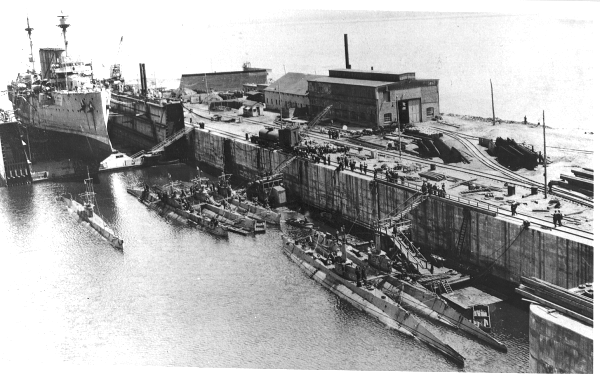British H Class Submarine on:
[Wikipedia]
[Google]
[Amazon]


 The British H-class submarines were Holland 602 type submarines used by the Royal Navy. The
The British H-class submarines were Holland 602 type submarines used by the Royal Navy. The
The Canadian built British H boats
{{Chilean submarines H Submarines of the Royal Canadian Navy


 The British H-class submarines were Holland 602 type submarines used by the Royal Navy. The
The British H-class submarines were Holland 602 type submarines used by the Royal Navy. The submarine
A submarine (or sub) is a watercraft capable of independent operation underwater. It differs from a submersible, which has more limited underwater capability. The term is also sometimes used historically or colloquially to refer to remotely op ...
s constructed for the British Royal Navy between 1915 and 1919 were designed and built in response to German boats which mined British waters and sank coastal shipping with ease owing to their small size. The H class was created to perform similar operations in German waters, and to attack German submarines operating in British waters.
Despite their cramped size and lack of a deck gun on some submarines, the class was popular amongst submariners, and saw action all around the British Isles, some being transferred as far as the Adriatic
The Adriatic Sea () is a body of water separating the Italian Peninsula from the Balkans, Balkan Peninsula. The Adriatic is the northernmost arm of the Mediterranean Sea, extending from the Strait of Otranto (where it connects to the Ionian Sea) ...
. Owing to the late arrival of most of the class, they were unable to have much impact in service, only destroying two German submarines and for the loss of four of their own number.
Post-war, many were retained in the Royal Navy for training purposes, while four more were lost in accidents during the 1920s. At the outbreak of the Second World War, the class was obsolete, but retained in training and coastal warfare roles to help the Royal Navy cope with heavy losses to the submarine fleet during the early stages of the war. Two were sunk in this role by German countermeasures. The Canada-built boats were equipped with Fessenden transducers, which were missing from the US-built boats.
Boats
Group 1
Group 1 was built in Canada at the Canadian Vickers Yards in Montreal before being transported across the Atlantic and deployed from Britain as British shipyards were too busy to construct submarines at this time. * – Launched May 1915 * – Launched June 1915 * – Launched June 1915. Mined and sunk July 1916 * – Launched June 1915 * – Launched June 1915. Rammed and sunk March 1918 * – Launched June 1915. Interned and purchased by the Dutch January 1916 * – Launched June 1915 * – Launched June 1915 * – Launched June 1915 * – Launched June 1915. Disappeared 1918Group 2
The second group was constructed simultaneously with the first group, but at Fore River Yard at Quincy, Massachusetts in the then-neutral United States. When the US government discovered the construction, they impounded all the completed units, only releasing them following their own declaration of war two years later. To escape this difficulty, the British government gave six units to the Chilean Navy as partial payment for the appropriation of six Chilean ships for British service in 1914. * – Launched 1915. * – Launched 1915. * – Launched 1918, transferred to Chile * – Launched 1919, transferred to Canada * – Launched 1918, transferred to Canada * – Launched 1918, transferred to Chile * – Launched 1918, transferred to Chile * – Launched 1918, transferred to Chile * – Launched 1918, transferred to Chile * – Launched 1918, transferred to ChileGroup 3
Group 3 was the largest group, and was constructed in 1917–1919 in Britain, shipyard space having been granted to the project and more boats needed following the seizure of those building in the United States. They were built by Vickers,Cammell Laird
Cammell Laird is a British shipbuilding company. It was formed from the merger of Laird Brothers of Birkenhead and Johnson Cammell & Co of Sheffield at the turn of the twentieth century. The company also built railway rolling stock until 1929, ...
, Armstrong Whitworth and William Beardmore at several locations, and most of the boats enjoyed long careers in the Royal Navy.
* – Launched 1918
* – Launched 1918
* – Launched 1918
* – Launched 1918
* – Launched 1918
* – Launched 1918
* – Launched 1918
* – Launched 1918. Sank in dockyard accident 1926
* – Launched 1918
* – Launched 1919. Mined and sunk 1941
* – Launched 1919
* – Launched 1919
* – Launched 1919
**Numbers ''H35-H40'' were ordered from Cammell Laird but cancelled in 1919
* – Launched 1918. Wrecked in collision 1920
* – Launched 1919. Wrecked in collision 1922
* – Launched 1919
* – Launched 1920
**Numbers ''H45'' and ''H46'' cancelled.
* – Launched 1919. Wrecked in collision 1929
* – Launched 1919
* – Launched 1919. Sunk by German surface units 1940
* – Launched 1920
* – Launched 1919
* – Launched 1919
*''H53'' and ''H54'' cancelled.
See also
*List of submarines of the Second World War
This is a list of submarines of World War II, which began with the German invasion of Poland on 1 September 1939 and ended with the surrender of Japan on 2 September 1945.
Germany used submarines to devastating effect in the Battle of the At ...
* List of submarine classes of the Royal Navy
This is a list of submarine classes of the Royal Navy of the United Kingdom. Dates of construction given.
Petrol-electric
Diesel-electric
* D class — 8 boats, 1908–1912
* E class — 58 boats, 1912–1916
* F class — 3 boats, 191 ...
Notes
Bibliography
*External links
The Canadian built British H boats
{{Chilean submarines H Submarines of the Royal Canadian Navy